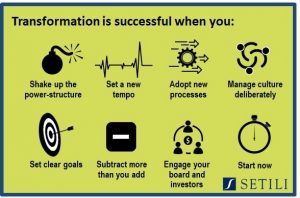 “Chief Transformation Officer” is a trending title. In the past year and a half, Equifax, UPS, Neiman Marcus, Service Master have created this role. Each company, however, means something different by the word transformation. With such diverse objectives, it’s no wonder that Chief Transformation Officers often have to chart their own paths.
“Chief Transformation Officer” is a trending title. In the past year and a half, Equifax, UPS, Neiman Marcus, Service Master have created this role. Each company, however, means something different by the word transformation. With such diverse objectives, it’s no wonder that Chief Transformation Officers often have to chart their own paths.
Here are the eight mistakes companies make most often when setting out to transform themselves:
Mistake #1: Bowing to the existing power-structure. People who have had the same boss for years get used to doing things the boss’s way. When you change reporting relationships, responsibilities and resources, however, you often find that employees become more receptive to new ideas. Old rivalries and vested interests may become irrelevant.
One organization I know broke up two important centralized functions, moving people who had formerly been in “shared services” groups out into the business units. Their alliances shifted overnight, and the transformation moved more smoothly. Consider what organizational structure changes might be beneficial for your transformation. You may find that it’s easier to reach your goals when teams are reconfigured.
Mistake #2: Maintaining an outdated tempo. Many of today’s transformations focus on becoming faster and more agile, yet management retains the decision processes designed for slower-moving economic environments. Successful transformations set a new metabolic rate for the organization.
One manufacturing firm we work with instituted weekly meetings to assess progress vs. specific transformation initiatives. The focus was on surfacing and solving problems and removing roadblocks. The meetings were quick and action-oriented. People began to move at a faster pace, and expected others to do the same. Because transformation results were visible to all, there was a sense of accomplishment that fueled ever-faster progress.
Mistake #3: Retaining policies and processes that are out of step with the new direction. Get rid of policies and processes that are misaligned with your transformation goals. If you need to transform your company quickly, taking a hard look at how decisions get made, and by whom, is a good place to start. One company I know reduced the number of executives required to approve capital expenditures from 12 to just 2, and allowed projects tied to the transformation to be put on a fast-track. This one change transformed both the speed and direction of the company’s efforts.
Mistake #4: Letting culture get the upper hand. Culture change is a big part of transformation, and having the right “tone at the top” is key. Successful transformations define explicitly how the culture must change, and take hard, visible action to make the shift. Visible signs of culture change include the words people use, who gets promoted and who doesn’t, what people are held accountable for, who spends time with whom, and how visible the top leaders are on a daily basis. A forest products company was successful in changing their culture when they clearly identified the aspects of culture they intended to change, and held leadership responsible for culture-related goals. Decide what cultural changes would aid your transformation, and pick two or three things that you can change immediately to shift in that direction.
As you do this, make sure you’ve considered all layers and functions in your company. Sometimes the top levels of the organization are on board with the transformation, but front line perspectives and needs are ignored. Sometimes it’s the opposite–vast resources are invested in transforming the front line culture and capabilities, but the transformation goes off the rails when the executive team continues to micro-manage, or drive for outdated goals. Don’t let your transformation fail because certain parts of the organization aren’t on board.
Mistake #5: Having murky goals. Setting goals that are scattered, vague or poorly communicated can derail any transformation. On the other hand, when your goals are clear, employees, investors, suppliers and customers understand what you are trying to achieve, and they help you get there. Equifax’s transformation is focused on upgrading security and delivering new value to customers. UPS’s transformation is focused on responding to macro-trends such as the rise in e-commerce and automation. Neiman Marcus’s transformation is focused on avoiding bankruptcy, building on its luxury brand, expanding in omnichannel, and investing in growth. Within these broad definitions, good CTOs narrow the focus to specific and measurable goals. They are clear about where the value lies, what objectives must be met to succeed, and what is non-negotiable.
Mistake #6: Adding, but not subtracting. Transformation is as much about what you are going to stop doing as what you are going to start doing. One role of the CTO is to say “no” to what was taken for granted in the past. And to make hard tradeoffs between competing priorities. Leaders who have spent years growing their divisions may bristle at the idea that resources will be pulled back, or businesses divested, but pruning is a necessary ingredient of most successful transformations.
Mistake #7: Underutilizing the board, or undercommunicating with investors. The CTO must assure that the company is investing in long-term transformation, while still meeting investor expectations short-term. That’s a hard balance to strike. Board members, especially those with past transformation experience, play a critical role in transformation. They can help you manage investor expectations, and can steer you away from costly mistakes.
Mistake #8: Waiting for the perfect time to start your transformation. Start before you need to. Most companies think they are starting the transformation before they need to, but once it’s underway, they realize they should have started even earlier. If you suspect that your company needs to transform itself to stay vibrant and successful, put the wheels in motion now. You won’t be sorry.
Is your company in the midst of a transformation? If it’s not, given the changes you see in your business environment, and the company’s projected performance, should it be? Are you at risk of making some of the above mistakes? Please share your experiences, and let me know if I’ve left anything out!
Amanda Setili is president of strategy consulting firm Setili & Associates. She is author of Fearless Growth: The New Rules to Stay Competitive, Foster Innovation, and Dominate Your Markets, and The Agility Advantage, How to Identify and Act On Opportunities in a Fast-Changing World.
For more strategies, videos and free materials, please visit www.setili.com. Or, contact Amanda to discuss how she works with companies to improve profits, performance and growth.



